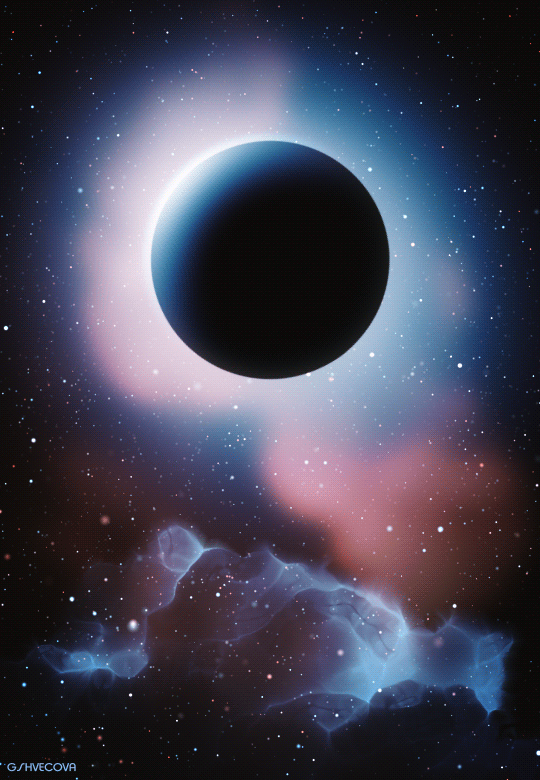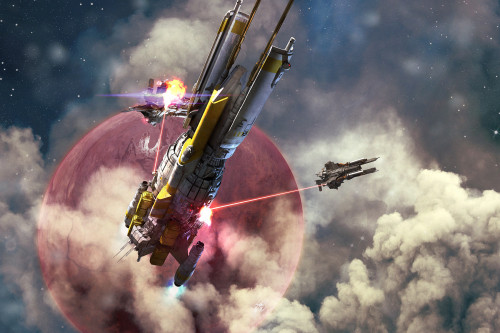‘jump’

‘jump’
More Posts from Epic-flight and Others

Wispy remains of a supernova explosion hide a possible ‘survivor.’ Of all the varieties of exploding stars, the ones called Type Ia are perhaps the most intriguing. Their predictable brightness lets astronomers measure the expansion of the universe, which led to the discovery of dark energy. Yet the cause of these supernovae remains a mystery. Do they happen when two white dwarf stars collide? Or does a single white dwarf gorge on gases stolen from a companion star until bursting? If the second theory is true, the normal star should survive. Astronomers used the Hubble Space Telescope to search the gauzy remains of a Type Ia supernova in a neighboring galaxy called the Large Magellanic Cloud. They found a sun-like star that showed signs of being associated with the supernova. Further investigations will be needed to learn if this star is truly the culprit behind a white dwarf’s fiery demise.
This supernova remnant is located 160,000 light-years from Earth. The actual supernova remnant is the irregular shaped dust cloud, at the upper center of the image. The gas in the lower half of the image and the dense concentration of stars in the lower left are the outskirts of a star cluster.
Image credit: NASA, ESA and H.-Y. Chu (Academia Sinica, Taipei)

Space shuttle re-entry.

Star Tunnel - 220319
View these celestial beauties taken by the Hubble Space Telescope and released as a set of views in a modern day “Messier Catalog."
Spotting comets was all the rage in the middle of the 18th century, and at the forefront of the comet hunt was a young French astronomer named Charles Messier. In 1774, in an effort to help fellow comet seekers steer clear of astronomical objects that were not comets (something that frustrated his own search for these elusive entities), Messier published the first version of his “Catalog of Nebulae and Star Clusters,” a collection of celestial objects that weren’t comets and should be avoided during comet hunting. Today, rather than avoiding these objects, many amateur astronomers actively seek them out as interesting targets to observe with backyard telescopes, binoculars or sometimes even with the naked eye.
Hubble’s version of the Messier catalog includes eight newly processed images never before released by NASA. The images were extracted from more than 1.3 million observations that now reside in the Hubble data archive. Some of these images represent the first Hubble views of the objects, while others include newer, higher resolution images taken with Hubble’s latest cameras.
Learn more: https://www.nasa.gov/content/goddard/hubble-s-messier-catalog
Make sure to follow us on Tumblr for your regular dose of space: http://nasa.tumblr.com.










LUNAR CHRISTMAS – On December 24, 1968, the astronauts of Apollo 8 became the first humans to orbit the Moon. They captured this sequence of amazing images along the way. (NASA)

Art G.Shvecova (Design graphics - Black-hole_080218)




Sci-fi art by Isaac Hannaford.

meirl
-
 foolxmonty liked this · 9 months ago
foolxmonty liked this · 9 months ago -
 fouxcinco reblogged this · 9 months ago
fouxcinco reblogged this · 9 months ago -
 frequentfeels reblogged this · 9 months ago
frequentfeels reblogged this · 9 months ago -
 tchiiw liked this · 9 months ago
tchiiw liked this · 9 months ago -
 olvckisntit liked this · 9 months ago
olvckisntit liked this · 9 months ago -
 krispapple liked this · 9 months ago
krispapple liked this · 9 months ago -
 lifewine liked this · 9 months ago
lifewine liked this · 9 months ago -
 ahappysushi reblogged this · 9 months ago
ahappysushi reblogged this · 9 months ago -
 between-sometime-and-eternity reblogged this · 9 months ago
between-sometime-and-eternity reblogged this · 9 months ago -
 hermit-hedge liked this · 9 months ago
hermit-hedge liked this · 9 months ago -
 shotguntabswag liked this · 9 months ago
shotguntabswag liked this · 9 months ago -
 f-perfect reblogged this · 9 months ago
f-perfect reblogged this · 9 months ago -
 mrwrightii reblogged this · 9 months ago
mrwrightii reblogged this · 9 months ago -
 mrwrightii liked this · 9 months ago
mrwrightii liked this · 9 months ago -
 else-self reblogged this · 9 months ago
else-self reblogged this · 9 months ago -
 else-self liked this · 9 months ago
else-self liked this · 9 months ago -
 maliciouscrow reblogged this · 9 months ago
maliciouscrow reblogged this · 9 months ago -
 doomunderthestairs liked this · 9 months ago
doomunderthestairs liked this · 9 months ago -
 rydengg reblogged this · 9 months ago
rydengg reblogged this · 9 months ago -
 siirbeardsalot reblogged this · 9 months ago
siirbeardsalot reblogged this · 9 months ago -
 c0ffeestains liked this · 9 months ago
c0ffeestains liked this · 9 months ago -
 hertroubledparadise reblogged this · 9 months ago
hertroubledparadise reblogged this · 9 months ago -
 savvygemineye reblogged this · 9 months ago
savvygemineye reblogged this · 9 months ago -
 savvygemineye liked this · 9 months ago
savvygemineye liked this · 9 months ago -
 yoogrimo reblogged this · 9 months ago
yoogrimo reblogged this · 9 months ago -
 xcessivebandit reblogged this · 9 months ago
xcessivebandit reblogged this · 9 months ago -
 leannasarah liked this · 9 months ago
leannasarah liked this · 9 months ago -
 cocoagadgetsworld reblogged this · 9 months ago
cocoagadgetsworld reblogged this · 9 months ago -
 cocoagadgetsworld liked this · 9 months ago
cocoagadgetsworld liked this · 9 months ago -
 tonystackinbandz reblogged this · 9 months ago
tonystackinbandz reblogged this · 9 months ago -
 hersheythecurious reblogged this · 9 months ago
hersheythecurious reblogged this · 9 months ago -
 megmoon1111 liked this · 9 months ago
megmoon1111 liked this · 9 months ago -
 sadasspisces reblogged this · 9 months ago
sadasspisces reblogged this · 9 months ago -
 sadasspisces liked this · 9 months ago
sadasspisces liked this · 9 months ago -
 sirblazebot reblogged this · 9 months ago
sirblazebot reblogged this · 9 months ago


